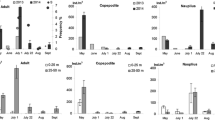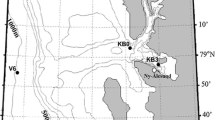Abstract
We studied the copepod Limnocalanus macrurus for seasonal variation in the composition of fatty acids, wax esters and sterols in large boreal lakes, where it occurs as a glacial-relict. Vast wax ester reserves of Limnocalanus were accumulated in a period of only two months, and comprised mono- and polyunsaturated fatty acids (PUFA) and saturated fatty alcohols. In winter, the mobilization of wax esters was selective, and the proportion of long-chain polyunsaturated wax esters declined first. PUFA accounted for >50 % of all fatty acids throughout the year reaching up to ca. 65 % during late summer and fall. Long-chain PUFA 20:5n-3 and 22:6n-3 together comprised 17–40 % of all fatty acids. The rarely reported C24 and C26 very-long-chain PUFA (VLC-PUFA) comprised 6.2 ± 3.4 % of all fatty acids in August and 2.1 ± 1.7 % in September. The VLC-PUFA are presumably synthesized by Limnocalanus from shorter chain-length precursors because they were not found in the potential food sources. We hypothesize that these VLC-PUFA help Limnocalanus to maximize lipid reserves when food is abundant. Sterol content of Limnocalanus, consisting ca. 90 % of cholesterol, did not show great seasonal variation. As a lipid-rich copepod with high abundance of PUFA, Limnocalanus is excellent quality food for fish. The VLC-PUFA were also detected in planktivorous fish, suggesting that these compounds can be used as a trophic marker indicating feeding on Limnocalanus.




Similar content being viewed by others
Abbreviations
- MUFA:
-
Monounsaturated fatty acid(s)
- PUFA:
-
Polyunsaturated fatty acid(s)
- TMTD:
-
4,8,12-Trimethyltridecanoic acid
- SFA:
-
Saturated fatty acid(s)
- VLC-PUFA:
-
Very-long-chain polyunsaturated fatty acid(s)
References
Hutchinson GE (1967) A treatise on limnology. Introduction to lake biology and the limnoplankton, vol 2. Wiley, New York
Segerstråle SG (1976) Immigration of glacial relicts into northern Europe. Boreas 5:1–7
Kane DD, Gannon JE, Culver DA (2004) The status of Limnocalanus macrurus (Copepoda: calanoida: Centropagidae) in Lake Erie. J Great Lakes Res 30:22–30
Warren GJ (1983) Predation by Limnocalanus as potentially major source of winter naupliar mortality in Lake Michigan. J Great Lakes Res 9:389–395
Peters J, Tuschling K, Brandt A (2004) Zooplankton in the arctic Laptev Sea—feeding ecology as indicated by fatty acid composition. J Plankton Res 26:227–234
Dahlgren K, Olsen BR, Troedsson C, Båmstedt U (2012) Seasonal variation in wax ester concentration and gut content in a Baltic Sea copepod [Limnocalanus macrurus (Sars 1863)]. J Plankton Res 34:286–297
Vanderploeg HA, Cavaletto JF, Liebig JR, Gardner WS (1998) Limnocalanus macrurus (Copepoda: Calanoida) retains a marine arctic lipid and life cycle strategy in Lake Michigan. J Plankton Res 20:1581–1597
Lee RF, Hagen W, Kattner G (2006) Lipid storage in marine zooplankton. Mar Ecol Prog Ser 307:273–306
van der Meeren T, Olsen RE, Hamre K, Fyhn HJ (2008) Biochemical composition of copepods for evaluation of feed quality in production of juvenile marine fish. Aquaculture 274:375–397
Cavaletto JF, Vanderploeg HA, Gardner WS (1989) Wax esters in two species of freshwater zooplankton. Limnol Oceanogr 34:785–789
Brett MT, Müller-Navarra DC, Ballantyne AP, Ravet JL, Goldman CR (2006) Daphnia fatty acid composition reflects that of their diet. Limnol Oceanogr 51:2428–2437
Burns CW, Brett MT, Schallenberg M (2011) A comparison of the trophic transfer of fatty acids in freshwater plankton by cladocerans and calanoid copepods. Freshw Biol 56:889–903
Dalsgaard J, St. John M, Kattner G, Müller-Navarra D, Hagen W (2003) Fatty acid trophic markers in the pelagic marine environment. Adv Mar Biol 46:225–340
Taipale S, Strandberg U, Peltomaa E, Galloway AWE, Ojala A, Brett MT (2013) Fatty acid composition as biomarkers of freshwater microalgae: analysis of 37 strains of microalgae in 22 genera and in seven classes. Aquat Microb Ecol 71:165–178
Hirche HJ, Fetzer I, Graeve M, Kattner G (2003) Limnocalanus macrurus in the Kara Sea (Arctic Ocean): an opportunistic copepod as evident from distribution and lipid patterns. Polar Biol 26:720–726
Graeve M, Albers C, Kattner G (2005) Assimilation and biosynthesis of lipids in Arctic Calanus species based on feeding experiments with a 13C labelled diatom. J Exp Mar Biol Ecol 317:109–125
Peters J, Renz J, van Beusekom J, Boersma M, Hagen W (2006) Trophodynamics and seasonal cycle of the copepod Pseudocalanus acuspes in the central Baltic Sea (Bornholm basin): evidence from lipid composition. Mar Biol 149:1417–1429
Brett MT, Müller-Navarra DC (1997) The role of highly unsaturated fatty acids in aquatic foodweb processes. Freshw Biol 38:483–499
Sargent JR, Bell G, McEvoy L, Tocher D, Estevez A (1999) Recent developments in the essential fatty acid nutrition of fish. Aquaculture 177:191–199
Stanley DW (2000) Eicosanoids in invertebrate signal transduction systems. Princeton University Press
Stillwell W, Wassall SR (2003) Docosahexaenoic acid: membrane properties of a unique fatty acid. Chem Phys Lipids 126:1–27
Nanton DA, Castell JD (1999) The effects of temperature and dietary fatty acids on the fatty acid composition harpacticoid copepods, for use as a live food for marine fish larvae. Aquaculture 175:167–181
Bell MV, Dick JR, Anderson TR, Pond DW (2007) Application of liposome and stable isotope tracer techniques to study polyunsaturated fatty acid biosynthesis in marine zooplankton. J Plankton Res 29:417–422
Koussoroplis AM, Nussbaumer J, Arts MT, Guschina IA, Kainz MJ (2014) Famine and feast in a common freshwater calanoid: effects of diet and temperature on fatty acid dynamics of Eudiaptomus gracilis. Limnol Oceanogr 59:947–958
Agaba MK, Tocher DR, Zheng X, Dickson CA, Dick JR, Teale AJ (2005) Cloning and functional characterisation of polyunsaturated fatty acid elongases of marine and freshwater teleost fish. Comp Biochem Physiol Part B:Biochem Mol Biol 142:342–352
Řezanka T (1989) Very-long-chain fatty acids from the animal and plant kingdoms. Prog Lipid Res 28:147–187
Käkelä R, Ackman RG, Hyvärinen H (1995) Very long chain polyunsaturated fatty acids in the blubber of ringed seals (Phoca hispida sp.) from Lake Saimaa, Lake Ladoga, the Baltic Sea, and Spitsbergen. Lipids 30:725–731
Mansour MP, Volkman JK, Holdsworth DG, Jackson AE, Blackburn SI (1999) Very-long-chain (C28) highly unsaturated fatty acids in marine dinoflagellates. Phytochemistry 50:541–548
Linko RR, Karinkanta H (1970) Fatty acids of long chain length in Baltic herring lipids. J Am Oil Chem Soc 47:42–46
Řezanka T, Dembitsky VM (1999) Very long chain polyunsaturated fatty acids in Crustacea of the order Bathynellacea. Biochem Syst Ecol 27:551–558
Subramoniam T (2000) Crustacean ecdysteroids in reproduction and embryogenesis. Comp Biochem Physiol Part C Toxicol Pharmacol 125:135–156
Goad LJ (1981) Sterol biosynthesis and metabolism in marine invertebrates. Pure Appl Chem 51:837–852
Mühlebach A, Albers C, Kattner G (1999) Differences in the sterol composition of dominant Antarctic zooplankton. Lipids 34:45–51
Urbanová K, Vrkoslav V, Valterová I, Háková M, Cvacka J (2012) Structural characterization of wax esters by electron ionization mass spectrometry. J Lipid Res 53:204–213
Anderson MJ, Gorley RN, Clarke KR (2008) PERMANOVA+ for PRIMER: guide to software and statistical methods. PRIMER-E Ltd
Clarke KR, Gorley RN (2006) PRIMER v6: user manual/tutorial. PRIMER-E Ltd
Galloway AWE, Lowe AT, Sosik EA, Yeung JS, Duggins DO (2013) Fatty acid and stable isotope biomarkers suggest microbe-induced differences in benthic food webs between depths. Limnol Oceanogr 58:1452–1462
Van Hove P, Swadling KM, Gibson JAE, Belzile C, Warwick FV (2001) Farthest north lake and fjord populations of calanoid copepods Limnocalanus macrurus and Drepanopus bungei in the Canadian high Arctic. Polar Biol 24:303–307
Rontani JF, Volkman JK (2003) Phytol degradation products as biogeochemical tracers in aquatic environments. Org Geochem 34:1–35
Le Borgne F, Demarquoy J (2012) Interaction between peroxisomes and mitochondria in fatty acid metabolism. Open J Mol Integr Physiol 2:27–33
Lee RF, Nevenzel JC, Paffenhöfer GA (1970) Wax esters in marine copepods. Science 167:1510–1511
Martin S, Parton RG (2006) Lipid droplets: a unified view of a dynamic organelle. Nat Rev Mol Cell Bio 7:373–378
Pond DW, Tarling GA (2011) Phase transitions of wax esters adjust buoyancy in diapausing Calanoides acutus. Limnol Oceanogr 56:1310–1318
Visser AW, Jónasdóttir SH (1999) Lipids, buoyancy and the seasonal vertical migration of Calanus finmarchicus. Fish Oceanogr 8:100–106
Sandström O (1982) The plankton fauna in the Gulf of Bothnia. In Müller K (ed) Coastal research in the Gulf of Bothnia, Monog Biol 45. W Junk Publ
Rahkola M, Avinski V, Holopainen AL, Jurvelius J, Karjalainen J, Viljanen M (1999) Interacting in the dark: a study of the diel vertical migrations of pelagic plankton and fish in Lake Ladoga. Boreal Environ Res 4:245–255
Ohvo-Rekilä H, Ramstedt B, Leppimäki P, Slotte JP (2002) Cholesterol interactions with phospholipids in membranes. Prog Lipid Res 41:66–97
Lee RF, Nevenzel JC, Paffenhöfer GA, Benson AA (1970) The metabolism of wax esters and other lipids by the marine copepod, Calanus helgolandicus. J Lipid Res 11:237–240
Allard B, Danger M, Ten-Hage L, Lacroix G (2011) Influence of food web structure on the biochemical composition of seston, zooplankton and recently deposited sediment in experimental freshwater mesocosms. Aquat Sci 73:113–126
Hassett RP (2004) Supplementation of a diatom diet with cholesterol can enhance copepod egg-production rates. Limnol Oceanogr 49:488–494
Persson J, Vrede T (2006) Polyunsaturated fatty acids in zooplankton: variation due to taxonomy and trophic position. Freshw Biol 51:887–900
Ravet JL, Brett MT, Arhonditsis GB (2010) The effects of seston lipids on zooplankton fatty acid composition in lake Washington. Ecology 91:180–190
Lau DCP, Vrede T, Pickova J, Goedkoop W (2012) Fatty acid composition of consumers in boreal lakes—variation across species, space and time. Freshw Biol 57:24–38
Kattner G, Graeve M, Hagen W (1994) Ontogenetic and seasonal changes in lipid and fatty acid/alcohol compositions of the dominant Antarctic copepods Calanus propinquus, Calanoides acutus and Rhincalanus gigas. Mar Biol 118:637–644
Kattner G, Albers C, Graeve M, Schnack-Schiel SB (2003) Fatty acid and alcohol composition of the small polar copepods, Oithona and Oncaea: indication on feeding modes. Polar Biol 26:666–671
Farkas T, Herodek S (1964) The effect of environmental temperature on the fatty acid composition of crustacean plankton. J Lipid Res 5:369–373
Albers CS, Kattner G, Hagen W (1996) The compositions of wax esters, triacylglycerols and phospholipids in Arctic and Antarctic copepods: evidence of energetic adaptations. Mar Chem 55:347–358
Sprecher H (2000) Metabolism of highly unsaturated n-3 and n-6 fatty acids. Biochim Biophys Acta: Mol Cell Biol Lipids 1486:219–231
Metz JG, Roessler P, Facciotti D, Levering C, Dittrich F, Lassner M, Valentine R, Lardizabal K, Domergue F, Yamada A, Yazawa K, Knauf V, Browse J (2001) Production of polyunsaturated fatty acids by polyketide synthases in both prokaryotes and eukaryotes. Science 293:290–293
Huggins AK, Munday KA (1968) Crustacean metabolism. In O Lowenstein (ed) Advances in comparative physiology and biochemistry, vol 3. Academic Press, New York
Dahlgren K, Andersson A, Larsson U, Hajdu S, Båmstedt U (2010) Planktonic production and carbon transfer efficiency along a north–south gradient in the Baltic Sea. Mar Ecol Prog Ser 409:77–94
Acknowledgments
This study was supported by Academy of Finland grants to Paula Kankaala (139786) and to Sami Taipale (251665). The help of Kari Ratilainen and the crew of R/V Muikku during the field sampling is greatly appreciated. We would also like to thank Dr. Tarja Katajisto (Finnish Environment Institute) and the crew of R/V Aranda for providing the Baltic Sea samples. We thank Aaron Galloway and the two anonymous reviewers for the constructive comments that greatly improved this manuscript.
Author information
Authors and Affiliations
Corresponding author
About this article
Cite this article
Hiltunen, M., Strandberg, U., Keinänen, M. et al. Distinctive Lipid Composition of the Copepod Limnocalanus macrurus with a High Abundance of Polyunsaturated Fatty Acids. Lipids 49, 919–932 (2014). https://doi.org/10.1007/s11745-014-3933-4
Received:
Accepted:
Published:
Issue Date:
DOI: https://doi.org/10.1007/s11745-014-3933-4




